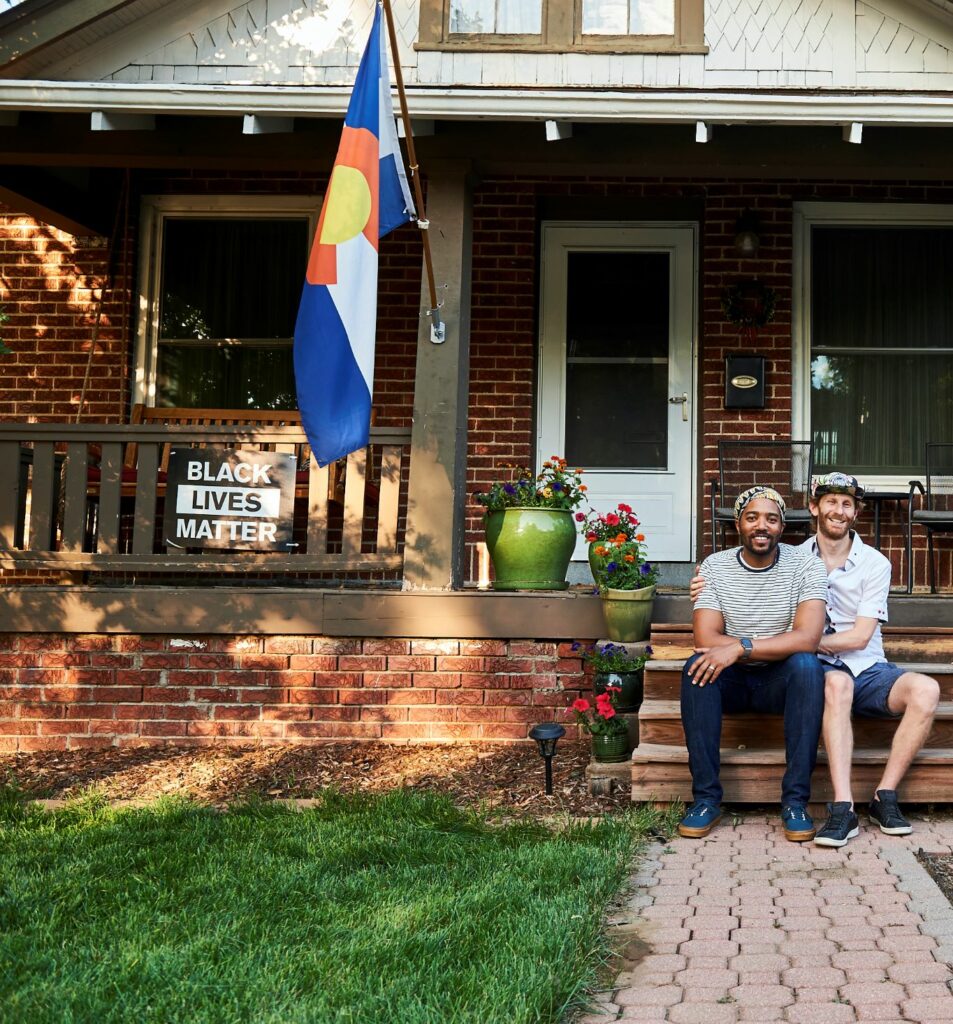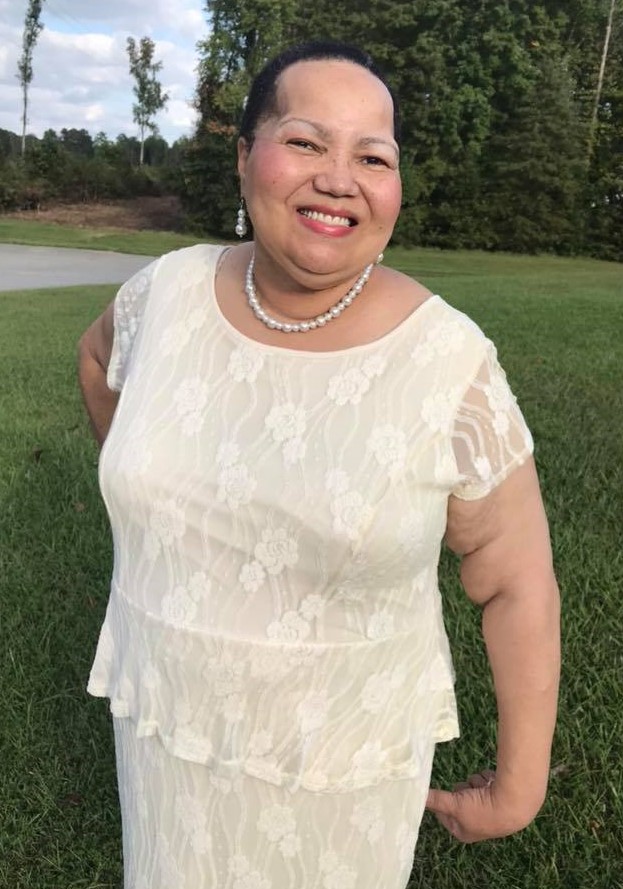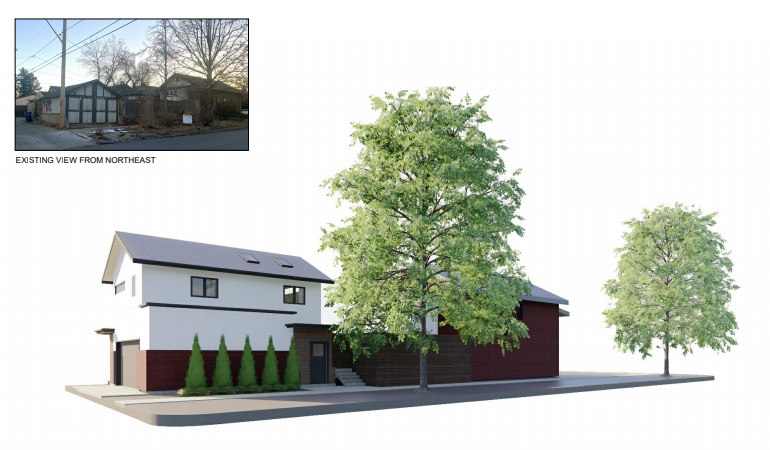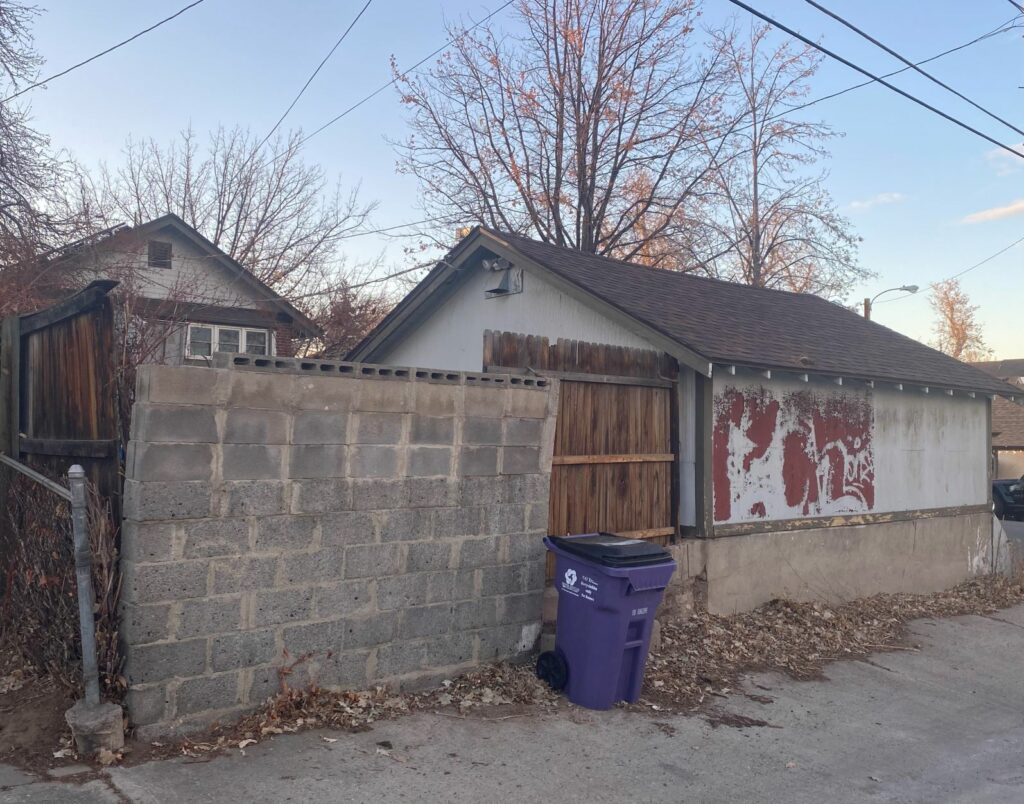
Sunnyside residents Shawn and Ben Johnson received wide-spread support for an Accessory Dwelling Unit (ADU) to house Shawn’s disabled mom, until they faced the Board of Adjustment for Zoning Appeals (BOA). After three unsuccessful hearings before the BOA, the Johnsons are making their case public, shining a spotlight on the chasm between a city’s vision for equity and aging-in-place, and an arcane zoning process interpreted by a board untethered from that vision.
When Shawn Johnson’s mother, Catherine Johnson, suffered a brain aneurysm in 1995, he and his brothers were young. Too young to help when the aneurysm led to a stroke, then paralysis down the left side of her body. “She’s brilliant and resolute on being a kind person. Raising three boys, she made sure we were capable young men who understood the importance of knowing right and doing right.” But at 10 years old, Shawn couldn’t take care of his mom.
Last year Ms. Johnson suffered another health setback, this time a lung infection. She spent two months in a North Carolina hospital in critical care on a ventilator before being released to rehab and eventually back home. Shawn spent several weeks by her side, then returned to Denver where he and his husband Ben agonized across the distance. They pictured a life where she lived close by, where they could look in on her.
The Johnsons live in an area of North Denver zoned for Accessory Dwelling Units (ADUs). They entertained ADU ideas allowing space for the piano lessons Ben teaches. Or a rental apartment for a local student. They hoped to need space in the house for growing their family someday.
But when Ms. Johnson fell ill last year, their attention turned entirely toward providing a home for her. They talked to her about living close to them as she faces a chapter in life where she might need more support. They pictured enjoying life’s daily moments together: morning coffee, their garden, a hug before saying goodnight.
Shawn and Ben rolled up their sleeves and set out to design an ADU that would work for Catherine. They navigated a complex maze of steps and a mind-boggling array of requirements. They visited with their next-door neighbors and Registered Neighborhood Organization (RNO), Sunnyside United Neighbors Inc (SUNI). SUNI’s Planning and Community Development Committee reviewed their design in two separate meetings and provided unanimous support in a vote of 10-0.
Together with an architect, builder, neighborhood support, and the City’s Community Planning and Development department, the Johnsons moved through several iterations to arrive at a design that worked. It worked for neighbors, it worked on their property, and most importantly, it worked for Ms. Johnson.
But it didn’t comply with Denver Zoning Code.

In order to create a second story studio apartment sufficient for Ms. Johnson’s needs, and allowing for the real possibility she will require a wheelchair someday, the design exceeded the maximum square footage currently allowed for the footprint of the building and the ADU on top.
Knowing their architect and builder have experience, and buoyed by the support they encountered in Sunnyside, Shawn and Ben felt optimistic they could successfully navigate the last steps. Their designs moved along through planning and permitting, and when they finally sat before the BOA on January 12, 2021, to request variances, they pictured Shawn’s mom moving in by Thanksgiving.
Board of Adjustment for Zoning Appeals
The five-member BOA operates as a Mayor-appointed body within the City’s Boards & Commissions. The BOA’s members serve staggered 5-year terms and receive $7,500 a year. There are two alternates. They often live in Denver but aren’t required to. Currently the BOA consists of an architect, restaurant developer, consultant, and two employees of the State of Colorado. All five current members are white, with three men and two women. Alternates include a white woman and a Hispanic man.
The BOA’s role is to hear and decide cases of the Denver Zoning Code; it is a place for human interface when a property owner’s circumstances could not have been foreseen by the Code. The BOA determines—through packets of exhibits and hearings—whether a variance request satisfies the unnecessary hardship criteria in the Code. Five hardship categories are laid out. One is disability.
Hearings are allotted roughly 30 minutes. For a variance to be granted, the case must receive Aye votes from 4 of 5 members.
City attorneys (a different one each week) and a representative from the Zoning department see plans during a previous stage and attend hearings to comment or participate in discussion. The City takes a position of In Support, Not Opposed, or Opposed. The BOA’s final decision can align with the City’s (it did in 2/3 of cases in 2019) but is not required to. A BOA result will sometimes be more lenient than the City’s position, sometimes less.

ADU’s of North Denver
North Denver consumes the lion’s share of ADU building permits in Denver, and subsequently, also a greater share of ADU variance requests. Of 26 permits issued so far in 2021, 16 were for addresses in 80211 or 80212. Of the 16 requests for ADU-related variances in 2020 and 2021, 6 were from North Denver. Five were denied. Zip codes like 80205, 80206, 80209, 80219 and 80236 had better luck.
The Hearings
The Johnsons were joined by their architect and builder at a Zoom hearing before the BOA on January 12. As they presented their 1.5 story garage/ADU design, they described Catherine Johnson’s disability and their goals to provide her with safe, permanent housing in close proximity. Their packet included architect’s drawings of the property, the proposed structure, and the surrounding area. There were letters of support from adjacent neighbors and SUNI. They attached confirmation of Ms. Johnson’s disability from the Social Security Administration and a letter from her doctor describing her disability and concluding with, “It is important she have appropriate accommodations, including wheelchair accessibility, and will benefit from having a caretaker close by.”
The 34-minute hearing took many directions, focusing at times on whether the large garage was “the minimum size necessary.” The Johnsons and their architect responded that the building footprint was sized in order that the 75% calculation of the ground floor allow a second story dwelling to meet Ms. Johnson’s needs. They reiterated the requirement for one long staircase for the lift that would ensure Ms. Johnson could access the studio apartment.

The City indicated it was Not Opposed. Toward the end, one member moved that the Variance be granted. It was seconded. A third member signaled he would actually be voting no. He was not convinced the garage space was required; he was more likely to support an altogether new variance allowing a second story greater than the allowable 75%.
The Chair summed it up: while there was some support for the design as it was, there was also clearly support for a design that shrank the ground floor. She ended by saying that she personally wanted to see a design in full compliance with code (no variances) and hear an explanation as to why such a design would not work for them. A continuance was granted, and the Johnson team left with the Chair’s three-part guidance.
The Johnsons came before the BOA again on March 2. A new Chair had been elected and there were two members present who had not been at the first hearing. A different City attorney was up in the rotation. The Johnson team came with a new design requiring 2 fewer variances than originally sought; it shrank the ADU floor area, asking for 13 square feet beyond the 650 allowed and 95 additional square feet for the building footprint.
Again, two members focused on the size of the garage. Again, the architect responded with the 75% calculation. The builder described all the changes that had been made. The architect pointed to a new page, a comparison between 2-story options and the 1.5 the Johnsons proposed. They had looked at many options, none able to avoid a variance. They sought the design that worked best for the family, the property, the neighborhood and Ms. Johnson, while keeping the overall number of variances to a minimum.
A theme emerged from the previous Chair: with new construction, she thought they could accomplish their goal within existing Code. To her it was the Johnsons’ choices that took the project out of Code, not their needs.
The member who showed support in the first hearing for a full second story clarified that he would have been more open to setback and bulk plane variance requests. He attempted a motion to propose this, but it was determined the rules did not allow for that level of complexity.
A member not at the first hearing was unclear whether they were definitely planning on Ms. Johnson needing a wheelchair at some point. Was this the case with the elevator?
And there were now two members who thought the Johnsons could design something with no code violations at all. The proposal failed when 2 dissenting votes were reached.
The Johnsons were confused and disheartened. After a round of costly redesigns and 45 minutes of discussion, they had been turned down. Shawn Johnson leaned into his Zoom square, “Would you explain what you would like us to do?” The Chair, noting the case was closed, replied, “You’re just going to have to comply with the Code.”
On March 23 the Johnson team made one more visit to the BOA, this time to appeal the March 2 decision. An alternate member from their first session was back, taking the place of a regular member who had attended the first two.
Support now included an appeal from neighborhood landscape architect and Blueprint Denver Task Force member Heather Noyes Gregg. Gregg highlighted that, “Throughout our neighborhood and in all publicly accessible buildings and spaces, improvements have been made to ensure all Denver residents are accommodated and provided access to participate equitably in our society.” She ended with, “As a member of the Blueprint Denver Task Force, our mission was to develop a vision for the City and County of Denver that would strengthen our city and make our neighborhoods welcoming and equitable for all members of our community, including the disabled. As a Denver resident, small business owner, and advocate of our neighbors and city, I urge you to reconsider your decision regarding the requested variance in Case 119‐20 and approve the requested variance.”
For the Johnsons’ appeal, Councilwoman Amanda P. Sandoval also now weighed in. Council members usually avoid involvement with variance requests, guiding property owners to seek support instead from neighbors and their RNO. The Johnsons had garnered that support leading up to the January hearing, with no apparent impact on the outcome. So Councilwoman Sandoval added her support, “The zoning code is a complex puzzle for which there are many subtle and varied solutions to best develop properties with unique hardships. I appreciate the challenge the Board faces and their expertise in interpreting the code for each unique case. At the same time, I encourage the Board to avoid splitting hairs when considering a case that has been so thoughtfully considered and will have such a minimal impact on adjacent properties and overall conformance with the zoning code.”
The zoning code is a complex puzzle for which there are many subtle and varied solutions to best develop properties with unique hardships. I appreciate the challenge the Board faces and their expertise in interpreting the code for each unique case. At the same time, I encourage the Board to avoid splitting hairs when considering a case that has been so thoughtfully considered and will have such a minimal impact on adjacent properties and overall conformance with the zoning code.
-Councilwoman Amanda P. Sandoval
A successful motion from one of the two members who denied the original request was required in order to re-open the case. The Chair solicited board members’ recollections of the disability aspect connected to the floorplan, as he was not in the first hearing. The alternate from the first meeting pointed back to a straight-run staircase required for accessibility. The previous Chair repeated that she thought they could accomplish their goal within existing Code.
Eleven minutes later, the Johnsons’ appeal was rejected.
Grasping for Straws
The Johnsons left each hearing unsettled. Something wasn’t right. Their project had support. It was such a small ask. Their mom’s disability was clear. Wasn’t it? Had the BOA read their letters?
As the Johnsons struggled to understand what they missed, they kept circling back to that uneasy feeling. Was it us? Or perhaps more accurately, was it their discomfort with us? “The goalpost kept moving,” Shawn Johnson recounted, “We watched other cases, before and after ours. Other families didn’t face the same scrutiny. The bar wasn’t as high for them. And we were the only Black family.” They had watched in disbelief as an imbalance in treatment unfolded before them on Zoom.
We watched other cases, before and after ours. Other families didn’t face the same scrutiny. The bar wasn’t as high for them. And we were the only Black family.
-Shawn Johnson
“We’re trained to believe in systems,” Ben added, “but here we were grasping for straws. Straws that weren’t connected to anything.” Then Shawn, “It was too subjective to be legitimate. I don’t know if the discrimination was based on race, but I do know we didn’t get equal access. And there was nothing anti-racist about it.”
The Johnsons love Sunnyside. Their neighbors came to the rescue, even during the pandemic, when their chicken coop needed some extra sets of hands to get into position on their property. Former piano students stop by to say hello; the food pantry is happy to receive their surplus eggs.
They’ve put plans to start a family on hold for the moment. Dreams of Thanksgiving spent with Catherine living in Denver have faded. Instead, they work their way through City entities, inviting them to see the flawed process. Ben points to a critical insight gained from the Black Lives Matter movement. They’re turning away from ideas and explanations centered around what they could’ve done differently and focusing now on the system’s failures. Shawn has contacted the Mayor’s office, the Office of Social Equity and Innovation, the City’s Board of Ethics, and he has described his family’s experience at City Council’s General Public Comment sessions.
In a city with clear equity goals woven throughout visionary documents like Blueprint Denver and Comprehensive Plan 2040, the municipal apparatus seems painfully unable to bring itself into alignment with its own values. The Johnsons’ only remedies are to settle on a cramped design that makes the ADU a less permanent option for Ms. Johnson or to cycle back through a subjective process, fingers crossed for a different outcome. Or as one city employee suggested: they could hire an attorney.
How does a racially homogenous group bring itself onto more solid ground when its built-in subjectivity has entered the realms of bias and exclusion?
Dena R. Samuels, PhD, Diversity, Equity, Inclusion & Belonging Coach, has one idea, “Bias shows up in all of us. It can impact the ways in which we interact with each other, especially across social differences. It’s not about shame or blame but rather to know that we all are exposed to messages in our culture that can cause us to see people in very specific ways that can cause exclusion, even unintentionally. We often hear people say, ‘I don’t have a biased bone in my body.’ Bias, however, simply means preference. We all have preferences. Unfortunately, some of those preferences are guided by stereotypes we’ve learned along the way, and have found their way into our brains, into our thinking about others, and into our interactions. Implicit/unconscious bias training is critically important for everyone (especially those who believe they don’t need it), to reflect on how those messages may have gotten stuck in our brains, and to learn strategies to minimize them so that we can make our processes and policies more culturally inclusive, where everyone feels like they belong.”
Heather Noyes Gregg also wonders about training for the BOA. The Blueprint Denver Task Force process included a 3-day session on equity and policy. It was a significant requirement for a volunteer, but she has no regrets, “It was eye opening. I’m glad I did it. Does the BOA somehow have permission to put on blinders in this regard?” “I admire the Johnsons for pushing, for helping the City to become better.”
Standing in the Gap
Two distinct languages emerged over the course of covering this story. One was the language of family, neighbors, and community. It was the language of a city striving to be its best, a neighborhood that wants for itself exactly what the Johnsons want: a place where everyone feels valued and welcome. A place where a son can now take care of his mother. It was a language steeped in the idea that we all play a part in this radical new form of family.
And at times it dripped with outrage and frustration, yearning for justice and fairness.
The other was a language of systems committed to endure as they are. This one spoke in a vocabulary of rules and complicated expertise. It moved the target but didn’t notice. It held out one straw after another. It didn’t listen much. It knew better.
Shawn and Ben Johnson stand now in a painful gap between these two. And if there’s anything the last year has taught us, it is that no one should ever have to stand in that place alone.

I’d like to know how we can get involved to hope these folks overcome the BOA. I’m assuming there’s a process for appealing this arbitrary and capricious decision making – likely to the Denver District Court. As neighbors, we should all kick in the funds (start with me) to pay the legal fees to do this right.
Ron, I signed up to speak about this at the next City Council open comment part of their meeting. I am focusing this time on this couple’s adu, but overall, I am wildly disappointed in the zero amount of change I saw happen with the new zoning code that came out promising all kinds of change and then my home’s zoning stayed exactly the same. I have experienced being told no for extremely simple ideas that make sense for my property. It’s like all that matters are these old zoning laws despite what we are seeing happen in real time in this city with regarding to housing costs.
You can sign up to speak on it here: https://www.denvergov.org/Government/Departments/Denver-City-Council/Public-Input/General-Public-Comment?fbclid=IwAR2YDfgo9rPSD9ObMyJToko2mUfoMYRAv5lGP6VOn2s3fABhAqCBWu4QpxI
We should have inspectors check the properties of those who’ve opposed these variances to verify that they’re up to code.
Agreed
We experienced the same thing with the board. Comments were made by board members that were incorrect. We were not allowed to correct those statements. We were treated with a dismissive tone. We see properties in our neighborhood being built exactly what we were asking for. And yes we are Black.